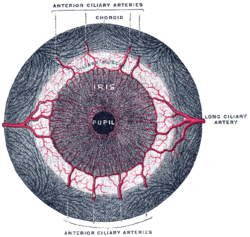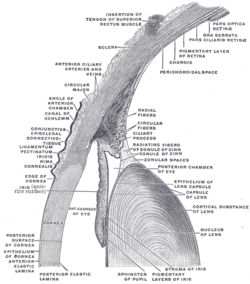| Iris dilator muscle | |
|---|---|
 Iris, front view. (Muscle visible but not labeled.) | |
 The upper half of a sagittal section through the front of the eyeball. (Iris dilator muscle is NOT labeled and not to be confused with "Radiating fibers" labeled near center, which are part of the ciliary muscle.) | |
| Details | |
| Origin | Outer margins of iris [1] |
| Insertion | Inner margins of iris [1] |
| Nerve | Long ciliary nerves (sympathetics) |
| Actions | Dilates pupil |
| Antagonist | Iris sphincter muscle |
| Identifiers | |
| Latin | musculus dilatator pupillae |
| TA98 | A15.2.03.030 |
| TA2 | 6763 |
| FMA | 49158 |
| Anatomical terms of muscle | |
The iris dilator muscle (pupil dilator muscle, pupillary dilator, radial muscle of iris, radiating fibers), is a smooth muscle [2] of the eye, running radially in the iris and therefore fit as a dilator. The pupillary dilator consists of a spokelike arrangement of modified contractile cells called myoepithelial cells. These cells are stimulated by the sympathetic nervous system. [3] When stimulated, the cells contract, widening the pupil and allowing more light to enter the eye.
Contents
- Structure
- Innervation
- Function
- History
- Etymology
- Additional images
- See also
- References
- External links
The ciliary muscle, pupillary sphincter muscle and pupillary dilator muscle sometimes are called intrinsic ocular muscles [4] or intraocular muscles. [5]




